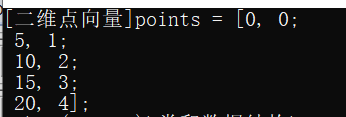C++下OpenCV学习笔记----OpenCV的输出方法
C++下OpenCV学习笔记
----OpenCV的输出方法
文章目录
-
- C++下OpenCV学习笔记
-
-
-
- 一.输出Mat类数据结构
- 二.输出其他常用的数据结构
-
-
一.输出Mat类数据结构
利用randu()函数产生的随机值填充矩阵:
randu(矩阵, 随机值的下限,随机值的上限);
- OpenCV默认风格
1>代码实现
#include- Python风格
1>代码实现
#include- 逗号分隔风格(CSV)
1>代码实现
#include- Numpy风格
1>代码实现
#include- C语言风格
1>代码实现
#include二.输出其他常用的数据结构
- 定义和输出二维点
1>代码实现
#include- 定义和输出三维点
1>代码实现
#include- 定义和输出基于Mat的std::vector
1>代码实现
#include- 定义和输出std::vector点
1>代码实现
#include





